+ データを開く
データを開く
- 基本情報
基本情報
| 登録情報 | データベース: PDB / ID: 8p3w | ||||||||||||
|---|---|---|---|---|---|---|---|---|---|---|---|---|---|
| タイトル | Homomeric GluA1 in tandem with TARP gamma-3, desensitized conformation 4 | ||||||||||||
 要素 要素 |
| ||||||||||||
 キーワード キーワード | MEMBRANE PROTEIN / AMPAR / ion channels / neurotransmission | ||||||||||||
| 機能・相同性 |  機能・相同性情報 機能・相同性情報Cargo concentration in the ER / axonal spine / positive regulation of locomotion involved in locomotory behavior / positive regulation of membrane potential / COPII-mediated vesicle transport / cellular response to ammonium ion / response to sucrose / postsynaptic neurotransmitter receptor diffusion trapping / neuron spine / myosin V binding ...Cargo concentration in the ER / axonal spine / positive regulation of locomotion involved in locomotory behavior / positive regulation of membrane potential / COPII-mediated vesicle transport / cellular response to ammonium ion / response to sucrose / postsynaptic neurotransmitter receptor diffusion trapping / neuron spine / myosin V binding / regulation of AMPA receptor activity / Trafficking of AMPA receptors / channel regulator activity / LGI-ADAM interactions / proximal dendrite / regulation of monoatomic ion transmembrane transport / response to arsenic-containing substance / cellular response to dsRNA / cellular response to L-glutamate / dendritic spine membrane / long-term synaptic depression / Synaptic adhesion-like molecules / beta-2 adrenergic receptor binding / cellular response to peptide hormone stimulus / response to morphine / neuronal cell body membrane / protein kinase A binding / neurotransmitter receptor localization to postsynaptic specialization membrane / peptide hormone receptor binding / cellular response to amine stimulus / response to psychosocial stress / spinal cord development / Activation of AMPA receptors / perisynaptic space / AMPA glutamate receptor activity / transmission of nerve impulse / Trafficking of GluR2-containing AMPA receptors / response to lithium ion / behavioral response to pain / AMPA glutamate receptor complex / adenylate cyclase binding / ionotropic glutamate receptor complex / immunoglobulin binding / asymmetric synapse / conditioned place preference / excitatory synapse / response to electrical stimulus / regulation of receptor recycling / G-protein alpha-subunit binding / positive regulation of excitatory postsynaptic potential / glutamate receptor binding / Unblocking of NMDA receptors, glutamate binding and activation / long-term memory / positive regulation of synaptic transmission / positive regulation of synaptic transmission, glutamatergic / postsynaptic density, intracellular component / protein targeting / neuronal action potential / voltage-gated calcium channel activity / response to fungicide / glutamate-gated receptor activity / synapse assembly / cellular response to brain-derived neurotrophic factor stimulus / glutamate-gated calcium ion channel activity / presynaptic active zone membrane / somatodendritic compartment / ionotropic glutamate receptor binding / dendrite membrane / ligand-gated monoatomic ion channel activity involved in regulation of presynaptic membrane potential / synaptic membrane / dendritic shaft / transmitter-gated monoatomic ion channel activity involved in regulation of postsynaptic membrane potential / response to cocaine / synaptic transmission, glutamatergic / PDZ domain binding / cellular response to amino acid stimulus / neuromuscular junction / response to nutrient levels / response to peptide hormone / postsynaptic density membrane / modulation of chemical synaptic transmission / recycling endosome / regulation of synaptic plasticity / cerebral cortex development / cellular response to growth factor stimulus / receptor internalization / small GTPase binding / response to toxic substance / Schaffer collateral - CA1 synapse / long-term synaptic potentiation / recycling endosome membrane / synaptic vesicle / synaptic vesicle membrane / cell-cell junction / intracellular protein localization / G-protein beta-subunit binding / response to estradiol / presynapse / amyloid-beta binding / cell body 類似検索 - 分子機能 | ||||||||||||
| 生物種 |  | ||||||||||||
| 手法 | 電子顕微鏡法 / 単粒子再構成法 / クライオ電子顕微鏡法 / 解像度: 3.53 Å | ||||||||||||
 データ登録者 データ登録者 | Zhang, D. / Krieger, J.M. / Yamashita, K. / Greger, I. | ||||||||||||
| 資金援助 |  英国, European Union, 3件 英国, European Union, 3件
| ||||||||||||
 引用 引用 |  ジャーナル: Nature / 年: 2023 ジャーナル: Nature / 年: 2023タイトル: Structural mobility tunes signalling of the GluA1 AMPA glutamate receptor. 著者: Danyang Zhang / Josip Ivica / James M Krieger / Hinze Ho / Keitaro Yamashita / Imogen Stockwell / Rozbeh Baradaran / Ondrej Cais / Ingo H Greger /   要旨: AMPA glutamate receptors (AMPARs), the primary mediators of excitatory neurotransmission in the brain, are either GluA2 subunit-containing and thus Ca-impermeable, or GluA2-lacking and Ca-permeable. ...AMPA glutamate receptors (AMPARs), the primary mediators of excitatory neurotransmission in the brain, are either GluA2 subunit-containing and thus Ca-impermeable, or GluA2-lacking and Ca-permeable. Despite their prominent expression throughout interneurons and glia, their role in long-term potentiation and their involvement in a range of neuropathologies, structural information for GluA2-lacking receptors is currently absent. Here we determine and characterize cryo-electron microscopy structures of the GluA1 homotetramer, fully occupied with TARPγ3 auxiliary subunits (GluA1/γ3). The gating core of both resting and open-state GluA1/γ3 closely resembles GluA2-containing receptors. However, the sequence-diverse N-terminal domains (NTDs) give rise to a highly mobile assembly, enabling domain swapping and subunit re-alignments in the ligand-binding domain tier that are pronounced in desensitized states. These transitions underlie the unique kinetic properties of GluA1. A GluA2 mutant (F231A) increasing NTD dynamics phenocopies this behaviour, and exhibits reduced synaptic responses, reflecting the anchoring function of the AMPAR NTD at the synapse. Together, this work underscores how the subunit-diverse NTDs determine subunit arrangement, gating properties and ultimately synaptic signalling efficiency among AMPAR subtypes. | ||||||||||||
| 履歴 |
|
- 構造の表示
構造の表示
| 構造ビューア | 分子:  Molmil Molmil Jmol/JSmol Jmol/JSmol |
|---|
- ダウンロードとリンク
ダウンロードとリンク
- ダウンロード
ダウンロード
| PDBx/mmCIF形式 |  8p3w.cif.gz 8p3w.cif.gz | 494.4 KB | 表示 |  PDBx/mmCIF形式 PDBx/mmCIF形式 |
|---|---|---|---|---|
| PDB形式 |  pdb8p3w.ent.gz pdb8p3w.ent.gz | 372 KB | 表示 |  PDB形式 PDB形式 |
| PDBx/mmJSON形式 |  8p3w.json.gz 8p3w.json.gz | ツリー表示 |  PDBx/mmJSON形式 PDBx/mmJSON形式 | |
| その他 |  その他のダウンロード その他のダウンロード |
-検証レポート
| 文書・要旨 |  8p3w_validation.pdf.gz 8p3w_validation.pdf.gz | 1.8 MB | 表示 |  wwPDB検証レポート wwPDB検証レポート |
|---|---|---|---|---|
| 文書・詳細版 |  8p3w_full_validation.pdf.gz 8p3w_full_validation.pdf.gz | 1.8 MB | 表示 | |
| XML形式データ |  8p3w_validation.xml.gz 8p3w_validation.xml.gz | 78.4 KB | 表示 | |
| CIF形式データ |  8p3w_validation.cif.gz 8p3w_validation.cif.gz | 113.3 KB | 表示 | |
| アーカイブディレクトリ |  https://data.pdbj.org/pub/pdb/validation_reports/p3/8p3w https://data.pdbj.org/pub/pdb/validation_reports/p3/8p3w ftp://data.pdbj.org/pub/pdb/validation_reports/p3/8p3w ftp://data.pdbj.org/pub/pdb/validation_reports/p3/8p3w | HTTPS FTP |
-関連構造データ
| 関連構造データ |  17397MC 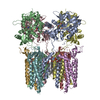 8c1pC 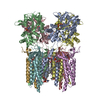 8c1qC 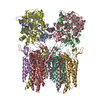 8c1rC  8c1sC 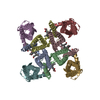 8c2hC 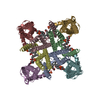 8c2iC  8p3qC  8p3sC 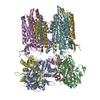 8p3tC 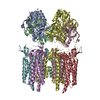 8p3uC 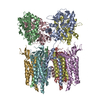 8p3vC  8p3xC  8p3yC  8p3zC  8pivC M: このデータのモデリングに利用したマップデータ C: 同じ文献を引用 ( |
|---|---|
| 類似構造データ | 類似検索 - 機能・相同性  F&H 検索 F&H 検索 |
- リンク
リンク
- 集合体
集合体
| 登録構造単位 | 
|
|---|---|
| 1 |
|
- 要素
要素
-タンパク質 , 2種, 8分子 ABCDEFGH
| #1: タンパク質 | 分子量: 102661.930 Da / 分子数: 4 / 由来タイプ: 組換発現 / 由来: (組換発現)   Homo sapiens (ヒト) / 参照: UniProt: P19490 Homo sapiens (ヒト) / 参照: UniProt: P19490#2: タンパク質 | 分子量: 35435.332 Da / 分子数: 4 / 由来タイプ: 組換発現 / 由来: (組換発現)   Homo sapiens (ヒト) / 参照: UniProt: Q8VHX0 Homo sapiens (ヒト) / 参照: UniProt: Q8VHX0 |
|---|
-非ポリマー , 4種, 47分子 
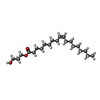
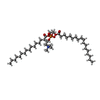




| #3: 化合物 | ChemComp-PLM / #4: 化合物 | ChemComp-OLC / ( #5: 化合物 | ChemComp-POV / ( #6: 水 | ChemComp-HOH / | |
|---|
-詳細
| 研究の焦点であるリガンドがあるか | N |
|---|---|
| Has protein modification | Y |
-実験情報
-実験
| 実験 | 手法: 電子顕微鏡法 |
|---|---|
| EM実験 | 試料の集合状態: PARTICLE / 3次元再構成法: 単粒子再構成法 |
- 試料調製
試料調製
| 構成要素 | 名称: Homomeric GluA1 AMPA receptor in tandem with TARP gamma 3, plus 1mM quisqualate タイプ: COMPLEX / Entity ID: #1-#2 / 由来: RECOMBINANT |
|---|---|
| 由来(天然) | 生物種:  |
| 由来(組換発現) | 生物種:  Homo sapiens (ヒト) Homo sapiens (ヒト) |
| 緩衝液 | pH: 8 |
| 試料 | 包埋: NO / シャドウイング: NO / 染色: NO / 凍結: YES |
| 急速凍結 | 凍結剤: ETHANE |
- 電子顕微鏡撮影
電子顕微鏡撮影
| 実験機器 |  モデル: Titan Krios / 画像提供: FEI Company |
|---|---|
| 顕微鏡 | モデル: TFS KRIOS |
| 電子銃 | 電子線源:  FIELD EMISSION GUN / 加速電圧: 300 kV / 照射モード: FLOOD BEAM FIELD EMISSION GUN / 加速電圧: 300 kV / 照射モード: FLOOD BEAM |
| 電子レンズ | モード: BRIGHT FIELD / 最大 デフォーカス(公称値): 2400 nm / 最小 デフォーカス(公称値): 1200 nm |
| 撮影 | 電子線照射量: 50 e/Å2 フィルム・検出器のモデル: GATAN K3 BIOQUANTUM (6k x 4k) |
- 解析
解析
| CTF補正 | タイプ: PHASE FLIPPING AND AMPLITUDE CORRECTION |
|---|---|
| 3次元再構成 | 解像度: 3.53 Å / 解像度の算出法: FSC 0.143 CUT-OFF / 粒子像の数: 75478 / 対称性のタイプ: POINT |
 ムービー
ムービー コントローラー
コントローラー


















 PDBj
PDBj















